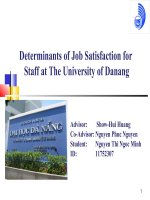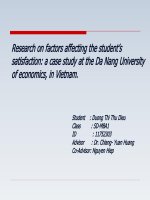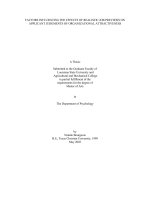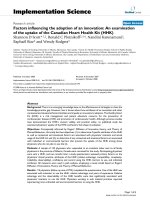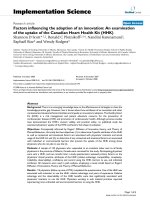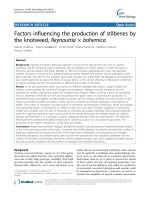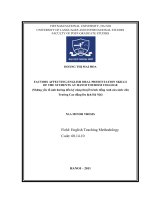Research about factors influencing the overall job satisfaction of employees at american polytechnic college
Bạn đang xem bản rút gọn của tài liệu. Xem và tải ngay bản đầy đủ của tài liệu tại đây (2.36 MB, 71 trang )
MASTER OF BUSINESS ADMINISTRATION
INTERNATIONAL PROGRAM
RESEARCH PROJECT
(BMBR5103)
RESEARCH ABOUT FACTORS INFLUENCING THE
OVERALL JOB SATISFACTION OF EMPLOYEES AT
AMERICAN POLYTECHNIC COLLEGE
STUDENT’S FULL NAME
:
HUYNH QUOC MINH CHAU
STUDENT ID
:
CGS 00019369
INTAKE
:
MARCH 2015
ADVISOR’S NAME & TITLE :
NGUYEN THE KHAI (DBA)
JULY 2016
ADVISOR’S ASSESSMENT
ACKNOWLEDGMENTS
..…………………………………………………………………………………………………………
..…………………………………………………………………………………………………………
..…………………………………………………………………………………………………………
..…………………………………………………………………………………………………………
..…………………………………………………………………………………………………………
To acknowledge the assistance of some individuals. I show deep respects
..…………………………………………………………………………………………………………
to what
..…………………………………………………………………………………………………………
they have already contributed to this paper simply because without their guidance
..…………………………………………………………………………………………………………
and understanding this research should not have been finished with flying colors.
..…………………………………………………………………………………………………………
Firstly, I am grateful to my advisor DBA. Khai Nguyen. His time, commitment,
..…………………………………………………………………………………………………………
..…………………………………………………………………………………………………………
and moreover his constant encouragement were the major factors contributing
and
..…………………………………………………………………………………………………………
creating inspiration and motivation for me to fulfill the paper.
..…………………………………………………………………………………………………………
..…………………………………………………………………………………………………………
Thanks to the board of managers and all employees of American Polytechnic
..…………………………………………………………………………………………………………
College for their precious time and efforts to collect data for this thesis.
..…………………………………………………………………………………………………………
I long for sending my sincerest and deepest gratitude to my family and all of my
ADVISOR’S SIGNATURE
sweet friends for their encouragement, and great
support.
(August
2016)
Huynh Quoc Minh Chau Student
NGUYEN THE KHAI (DBA)
CONTENTS
CHAPTER 1: INTRODUCTION
1
1.1. Problem statement
1
The establishment & developmental process of American Polytechnic
College
3
Organization structure
8
Training Programs
8
1.2. Research Objectives
9
1.3. Scope and Methodology of Research
10
1.4. Significance, limitations and future researches
11
1.5. Research structure
11
CHAPTER 2: LITERATURE REVIEW
2.1 Job satisfaction and job motivation
13
13
2.1.1. Definition of job satisfaction
13
2.1.2. Job satisfaction and job motivation
13
2.2. Theories of Job Satisfaction
13
2.2.1. Maslow’s theory
14
2.2.2. Alderfer’s theory
15
2.2.3. Herzberg’s theory
17
2.2.4. McClelland’s theory
20
2.2.5. Summary
21
CHAPTER 3: RESEARCH MODEL AND HYPOTHESES.
23
3.1. Research Model
23
3.2. Research Hypotheses
23
3.2.1. Satisfaction with my supervisor
23
3.2.2. Employee satisfaction with influence and ownership
24
3.2.3. Occupational stress scale
24
3.2.4. Satisfaction with work schedule flexibility
25
CHAPTER 4: RESEARCH METHODS
26
4.1. Research Design
26
4.2. Research methods
26
4.2.1. Satisfaction with my superior
26
4.2.2. Employee satisfaction with influence and ownership
28
4.2.3. Occupational stress scale
30
4.2.4. Satisfaction with work schedule flexibility
32
4.3. Data Analysis and Report
33
4.3.1. Demographic characteristics of the respondents
35
4.3.2. Reliability analysis
36
4.3.3. Descriptive analysis
39
4.3.4. Correlation of all variables statistics.
41
4.3.5. Hypothesis testing
42
CHAPTER 5: DISCUSSION AND CONCLUSIONS
47
5.1. Discussion
47
5.1.1. Recommendations for satisfaction with my superior
47
5.1.2. Recommendations for employee satisfaction with influence
47
and ownership
5.1.3. Recommendations for occupational stress scale
47
5.1.4. Recommendations for satisfaction with work schedule flexibility
48
5.2. Limitation of Study
48
5.3. Conclusions
49
APPENDIX
50
REFERENCES
60
CHAPTER 1: INTRODUCTION
1.1. Problem statement:
Now, as global competition, the integration of the companies, big corporations, the
organizational restructuring, and technology changes quickly. So each person has the
choices to develop their career. Career satisfaction is idiosyncratic assessment of each
individual in their career, and are viewed as a key indicator of the success of your career
(Abele, Spurk & Volmer, 2011; Boudreau, Boswell & Judge, 2001; Judge, Cable,
Boudreau, & Bretz, 1995; Ng et al., 2005). That is an evaluation each individual's
progress toward the goals that relate to your career (income, experience, achievement,
development). Today, organizations are increasingly conscious of the development staff,
make the commitment, provides opportunities, facilitate learning, so that employees with
the college, build loyalty. This as a long term commitment between individuals and
companies about loyalty, cohesive and accountable to work in Exchange for job stability,
career development, training, and promotion opportunities (Feldman, 2000). This is the
mutual investments between individual and organization in a long term. The diversity of
career goals that lead to the development of each individual is different. When success in
careers is consider subjective, psychological and perceptions of each person, the
organization will be very difficult to meet and develop opportunities (Feldman, 2000;
Hall, 2002).
Previous studies focused towards satisfaction in a career directly related to success in
your career. But the recent research demonstrates an increasing emphasis on peoples
subjective evaluations of their career. (Ng et al., 2005; Savickas, 1995).
1
Therefore, organizations must link the development of his college's benefits with the
development of employee benefits. The staff in a long time with an organization will
bring stability and sustainable development. Therefore, enterprises must create a
favorable environment for employee’s development, helping them realize the work.
Besides, employees need to recognize the right of his career and have long term goals,
clearly.
Therefore, these factors will affect the career satisfaction of personal? That factors come
from organizations or their own personal? How is factors impact to career satisfaction?
Based on previous studies, this research give 4 factors impact to career satisfaction and
that factors and may answer the question why some people not success in career but they
satisfaction with their career.
2
THE ESTABLISHMENT AND DEVELOPMENTAL PROCESS OF AMERICAN
POLYTECHNIC COLLEGE
American Polytechnic College (APC), one of the oldest colleges and most prestigious in
Vietnam and known as VATC before, built and invested by US experts and Vietnam.
Vietnamese American Vocational Training College Training VATC Colleges and
Intermediate levels in the same system with the American English Language Center
Vietnam VATC.
- 30/07/2007 with the achievements in education and training, the Ministry of Labour Invalids and Social Welfare to allow the center to upgrade from English
into VIETNAMESE AMERICAN COLLEGE OF PROFESSIONAL VATC.
3
Headquartered at 21 Le Quy Don Street, District 3, HCMC. Ho Chi Minh. Experiencing
the period of formation and development, the system of Vietnamese American
Vocational Training College VATC expanded network of over 13 branches in many
provinces and cities nationwide. The number of college students has increased every year
schools and to date has reached over 5,000.
Memorable milestones:
- In 2000, VATC signed cooperation with the University of Cambridge (UK) English
language teaching programs and training rank College Cambridge International
Examination program (CIE)
- Since 2003, the official training and college degree program affiliated with the
University of Cambridge (UK).
- 30/07/2007, upgrading from the school system to school system with functions Job
College Job Training Colleges and Intermediate and officially changed its name from the
Vietnamese American Training Schools into Colleges Vietnamese American vocational
VATC.
- 24/11/2007, VATC signed a Cooperation Agreement with the University of Broward
(BC), United States, training programs under the credit system to obtain a Degree
College of Information Technology industries, Business Administration, Hospitality and
Tourism management. VATC becomes the only international partner of Broward in
Vietnam.
.
- In early 2009, Vietnamese American Vocational Training College official VATC
invested
and
managed
100%
by
Blackhorse
Group
(USA).
4
- 1/10/2009, VATC training signed cooperation programs with the College of Foreign
Languages
Faculty
Training
Institute
Australasian-ATA
(Australia).
- Continuous two consecutive years 2009 and 2010, Vietnamese American Vocational
Training College VATC honored to receive the Golden Dragon Award - awards voted
enterprises invested abroad have made important contributions to the development of
Vietnam economy.
- With the criterion: "The quality of training is priority No. 1," Vietnamese American
Vocational Training College VATC investment focus on systems of modern facilities and
standards to ensure that students always have access VATC advanced technology in the
world. In addition, faculty experience and enthusiasm in the Vietnamese American
Vocational Training College VATC are graduates from prestigious universities at home
and abroad such as the University of California (USA), National University (Australia),
RMIT University (Australia), University of Innotech France (France), University of
Waterloo (Canada), Nanyang Technological University (Singapore), University of Ulsan
(Korea), Asian Institute of technology (AIT) ... the morning teaching methods created to
help students quickly acquire knowledge and proficiency skills in practice.
To help students practice skills early career, VATC trying to create conditions for
students to get acquainted with the reality while still in school by distributing nearly 70%
of total training time for the hours of practice . In addition, the school has links with
businesses so that students can practice and conditions is set at now. This creates
tremendous advantages for students as experience was gained from the application of
what was learned immediately into practice. Practical experience since then also more
5
arid theoretical studies and confusing. All these things help students after graduation
VATC quickly get a job like that. The figure 91% of graduates get job within 3 months
after graduation was testament to the quality of teaching in Vietnamese American
Vocational Training College VATC.
- In 2014, Vietnamese American Vocational Training College VATC changed their name
into American Polytechnic College after getting the investment from TNK Capital.
- The educational philosophy of American Polytechnic College is aimed at building skills
and positive attitude of the students so that they can quickly update and master new
knowledge, be able to adapt, treatment, and success in all conditions and situations. To
realize this philosophy, American Polytechnic College used the method of "training
through problem solving" (problem-based learning) and "through practical training"
(worked based learning) to take on teaching issues subject, practical situations going on
in life, the current debate will be brought up for discussion and debate to build student
skills in problem solving (problem solving) and thinking skills Reviewer (critical
thinking). The lesson is based on the discussions, debates and group work to help
students mature, there are independent thinkers, confident in life and work later. In
addition, English language skills are indispensable in the era of integration and
globalization. At American Polytechnic College, students will be required to use English
as a language to communicate regularly to become familiar with international work
environment. All aim to build a new generation of truly "Confident - Maturing" in the
new era.
6
In addition, APC is also a modern educational environment, the system uses the facilities
of international standards. Classrooms are equipped with modern: projector, DVD player,
sound, lighting and catering equipment for other learning ... has been certified to meet
international standards. All classrooms are the most suitable design to create a sense of
comfort and convenient for students to participate in learning Vietnamese in America.
7
Organization structure
Training Programs
8
American Polytechnic College (APC) is the environment gives you sufficient knowledge
and skills to complete his journey a success. The goal of the school is to help you conquer
even the most demanding employers.
1.2. Research Objectives:
Greenhaus, J H., Parasuraman, A Wowormley, W. M (1990) measures satisfaction with
career success, an internally generated and defined career outcome, beside career
satisfaction correlated with salary level, number of promotions received, perceptions of
upward mobility…There are many factors that affect career satisfaction, so research what
main factors are significantly impact to career satisfaction, it’s very important for an
organization. This study implements a survey of the employees of American Polytechnic
College (hereafter APC) about satisfaction of their career.
9
The aims of this study are to:
- To investigate the key factors determining career satisfaction.
- To analyze current career satisfaction on employees at APC.
- To identify the basic model of career satisfaction
- To improve the career satisfaction of APC.
1.3. Scope and Methodology of Research:
The purpose of this research is career satisfaction and factors effect to it.
Consider perceptions of employees with career and suitability of employees to the
organization. Data were collected based on surveys of employees satisfaction in the
industry, the factors affecting it, such as the perception of the industry, the organization's
commitment to the cause, the possibility of development experience, as well as the
suitability of the individual's perception of the organization. Factors were isolated for
study, in order to make major impacts. In this research, the author limits the scope of the
research employees of the college, not implementation the research object is the board of
directors. The study was conducted at APC campus. Implementation period is 2016. In
this study, the author used quantitative methods to survey and assess the career
satisfaction of employees based on 5-point scale. The author used a questionnaire as a
tool to collect data and information of the object. This questionnaire will be processed the
data to make the results based on the scale was constructed. The questionnaire is listed in
the Appendix section.
Research helps us to have an overview of career satisfaction, factors affecting to it. Since
then the organization can establish a plan, policy organizations to improve career
10
satisfaction. The research of career satisfaction has very important significance in
connecting employees with organization. It brings stability development for organization.
For employees in career satisfaction shown satisfaction about the psychology of
individuals with their career. From there they can express themselves, develop skills, and
develop loyalty to the organization.
This study is limited in the number of employees participating in the survey.
Culture of companies is different, leading to the perception of individuals with different
career.
1.4. Significance, limitations and future researches:
Research helps us to have an overview of career satisfaction, factors affecting to it. Since
then the organization can establish a plan, policy organizations to improve career
satisfaction. The research of career satisfaction has very important significance in
connecting employees with organization. It brings stability development for organization.
For employees in career satisfaction shown satisfaction about the psychology of
individuals with their career. From there they can express themselves, develop skills, and
develop loyalty to the organization.
This study is limited in the number of employees participating in the survey. Culture of
companies is different, leading to the perception of individuals with different career.
1.5. Research structure:
In this thesis is divided into five parts. The first part is Introduction providing problem
statement, Research Objectives, Scope and Methodology of Research, Significance,
limitations and future researches. Then, Literature review provides a theoretical
11
framework and hypotheses. The next part Research Methodology including data
collection and measures are described. The next part summarizes the research findings,
based on a confirmatory factor analysis. Finally, the implications, limitations, and future
research areas are discussed.
12
CHAPTER 2: LITERATURE REVIEW
This chapter addresses the literature review with two focuses. Firstly, it presents and
discusses theories of job satisfaction. Then, it reviews studies of job satisfaction of
teachers all over the world.
2.1. Job satisfaction and job motivation
2.1.1. Definition of Job satisfaction
Job satisfaction has been considered to be function of the perceived relationship between
what one wants from one’s job and what one perceives it is offering (Locke, 1969: 316,
reported in Sinclair, 1992,) and as the degree of “fit” between what an organization
requires of its teacher or employees and what the teacher or employees are seeking from
the firm (Mumford, 1972: 5, reported in Sinclair, 1992).
2.1.2. Job satisfaction and job motivation
According to Michaelowa (2002), job satisfaction is not the same as job motivation.
These terms are related but January not be used as synonyms. While job satisfaction gives
an indication of teachers’ well-being induced by the job, motivation is defined as their
willingness, drive or desire to engage in good teaching.
However, the definitions of job satisfaction and motivation are usually overlapped and in
a lot of researchers, they are considered similar. Therefore, in this research, job
satisfaction is not only the well-being but also the willingness and drive of the teachers.
2.2. Theories of Job Satisfaction
According to McShane & Von Glinow (2003), satisfaction theories fall into two main
categories: content theories. Content theories explain the dynamics of teacher or
13
employee needs, such as why people have different needs at different times. By
understanding a teacher or employee’s needs, we can discover the conditions that
motivate that person. Process theories describe the processes through which needs are
translated into behavior. They help us understand, predict, and influence teacher or
employee performance, attendance, etc. In the scope of the study, only content theories
were used due to their relationship with the study objective (identifying factors that
influence Teachers’ job satisfaction.) The four following theories are considered
dominating content theories of satisfaction and are written in the viewpoint of McShane
& Von Glinow (2003).
2.2.1. Maslow’s theory
One of the earliest and best well-known theories is needs hierarchy theory. Developed by
psychologist Abraham Maslow, this theory condenses the numerous needs that scholars
have identified into a hierarchy of five basic categories. At the bottom are physiological
needs, which include the need to satisfy biological requirements for food, air, water, and
shelter. Next come safety needs – the need for a secure and stable environment and the
absence of pain, threat, or illness. Belongingness includes the need for love, affection,
and interaction with other people. Esteem includes self – esteem through personal
achievement as well as social esteem through recognition and respect from others. At the
top of the hierarchy it – actualization, which represents the need for self – fulfillment – a
sense that the person’s potential has been realized.
Maslow recognized that a teacher or employee’s behavior is motivated simultaneously by
several need levels, but behavior is motivated mostly by the lowest unsatisfied need at the
14
time. As the person satisfies a lower – level need, the next higher need in the hierarchy
becomes the primary motivator. This concept is known as the satisfaction – progression
process. Even if a person is unable to satisfy a higher need, he or she will be motivated by
it until it is eventually satisfied. Physiological needs are initially the most important, and
people are motivated to satisfy them first. As they become gratified, safety needs emerge
as the strongest motivator. As safety needs are satisfied, belongingness needs become
most important, and so forth. The exception to the satisfaction – progression process is
self – actualization; as people experience self – actualization, they desire more rather than
less of this need.
Although Maslow’s needs hierarchy is one of the best-known behavior theories, the
model is much too rigid to explain the dynamic and unstable characteristics of teacher or
employee needs. Researchers have found that individual needs do not cluster neatly
around the five categories described in the model. Moreover, gratification of one need
level does not necessarily lead to increased motivation to satisfy the next higher need
level. Although Maslow’s model January not predict teacher or employee needs as well as
scholars initially expected, it provides an important introduction to teacher or employee
needs and has laid the foundation for Alderfer’s ERG theory, which has better research
support.
2.2.2. Alderfer’s theory
ERG theory was developed by organizational behavior scholar Clayton Alderfer to
overcome the problems with Maslow’s needs hierarchy theory. ERG theory goups human
needs into three broad categories: existence, relatedness, and growth (the theory’s name is
15
based on the first letter of each need). Existence need correspond to Maslow’s
belongingness needs. Growth needs correspond to Maslow’s esteem and self –
actualization needs.
Existence needs include a person’s physiological and physically related safety needs,
such as the need for food, shelter, and safe working conditions. Relatedness needs include
a person’s need to interact with other people, receive public recognition, and feel secure
around people (i.e. interpersonal safety). Growth needs consist of a person’s self – esteem
through personal achievement as well as the concept of self – actualization presented in
Maslow’s model.
ERG theory states that an teacher or employee’s behavior is motivated simultaneously by
more than one need level. Thus, you might try to satisfy your growth needs (such as
competing an assignment exceptionally well) even though your relatedness needs are not
completely satisfied. ERG theory applies the satisfaction – progression process described
in Maslow’s needs hierarchy model, so one need level dominates a person’s motivation
more than others. As existence needs are satisfied, for example, relatedness needs become
more important.
Unlike Maslow’s model, however, ERG theory includes a frustration – regression process
whereby those who are unable to satisfy a higher need become frustrated and regress to
the next lower need level. For example, if existence and relatedness needs have been
satisfied, but growth need fulfillment has been blocked, the individual will become
frustrated and relatedness needs will again emerge as the dominant source of motivation.
Although not fully tested, ERG theory seems to explain the dynamics of human needs in
16
organizations reasonably well. It provides a less rigid explanation of teacher or employee
needs than Maslow’s hierarchy. Human needs cluster more neatly around the three
categories proposed by Alderfer than the five categories in Maslow’s hierarchy. The
combined processes of satisfaction – progression and frustration – regression also provide
a more accurate explanation of why teacher or employee needs change over time.
Overall, it seems to come closest to explaining why teacher or employees have particular
needs at various times.
2.2.3. Herzberg’s theory
Motivator – hygiene theory differs from Maslow’s and Alderfer’s needs hierarchy models
because it does not suggest that people change their needs over time. Developed by
scholar Frederick Herzberg, this theory proposes that teacher or employees are motivated
primarily by growth and esteem needs, such as recognition, responsibility, advancement,
achievement, and personal growth. These factors are called motivators because teacher or
employees experience job satisfaction when the factors are received and are therefore
motivated to obtain them. Factor extrinsic to the work, called hygiene, affect the extent to
which teacher or employees feel job dissatisfaction. Hygiene includes job security,
working conditions, School policies, co-worker relations, and supervisor relations.
Improving hygiene will reduce job dissatisfaction, but hygiene will have almost no effect
on job satisfaction or teacher or employee motivation.
A unique characteristic of motivator – hygiene theory is that it does not view job
satisfaction and dissatisfaction as opposites. Improving motivators increases job
satisfaction, but it does not decrease job dissatisfaction. Improving hygienes reduce job
17
dissatisfaction, but it does not increase job satisfaction. Job satisfaction is produced by
growth fulfillment and other work content outcomes, whereas job satisfaction is produced
by the work context. Thus, Herberg’s theory differs from Maslow’s and Alderfer’s
hierarchy models by suggesting that growth needs represent the only source of
motivation.
In more colloquial terms, a job with good hygiene factors like an air-conditioned office,
cushy benefits, and a lenient vacation policy will make an teacher or employee show up
for work. However, the teacher or employee will be unlikely to burn the midnight oil and
think about her work on the weekends unless the position also offers opportunities for
intellectual and professional growth. (This might be described as the difference between a
“job” and a “career”).
How does a manager create motivating factors and then schooling teacher or employee
satisfaction? Three practices based on the motivation-hygiene theory are job enlargement,
job enrichment, and job rotation.
Job enlargement (also known as horizontal job loading) combines tasks into one job. This
approach might involve combining two or more complete jobs into one, or just adding
one or two more tasks to an existing job. Either way, the job’s skill variety has increased
because there are more tasks to perform.
However, job enlargement often fails to achieve the desired results. In too many cases,
job enlargement simply makes a teacher or employee “busier” without making the job
itself more interesting or rewarding.
18
Job rotation is a systematic process of shifting workers from one specialized job to
another. The idea is to prevent boredom by periodically giving each teacher or employee
a new set of responsibilities. Job rotation is used by many organizations.
Job rotation can alleviate the “ruts” which inevitably occur when a teacher or employee
performs the same set of tasks for years on end. However, this is not the only benefit of
the practice. Another advantage of job rotation is cross training. A teacher or employee
who works in multiple functional areas adds to his or her skills portfolio. This benefits
the organization as well as the teacher or employee. An organization that has a large
number of cross-trained teacher or employees can flexibly respond to changes in its
internal and external environment, shifting workers to the areas in which they are needed
most at a given time. The worker, meanwhile, builds a resume that contains multiple
areas of expertise – or at least multiple areas of experience.
Job rotation is not, however, a panacea by itself. If the jobs in an organization are
intrinsically boring, then the enthusiasm that a teacher or employee feels at the beginning
of each new assignment will quickly dissipate. Job rotation also decreases efficiency.
When a teacher or employee begins a new assignment, it will take some time for him to
master unfamiliar tasks. Therefore, an organization that uses job rotation must take steps
to ensure proper teacher or employee training in each functional area.
Although more complex, job enrichment is considered to be superior to both job
enlargement and job rotation. Job enrichment uses vertical loading to expand an teacher
or employee’s control over his work while simultaneously increase his range of
responsibility. Job enrichment can therefore be a source of motivational factors. The
19
teacher or employee who is more in control will have a greater chance of experiencing
professional growth, recognition, and achievement and the satisfaction that follows.
2.2.4. McClelland’s theory
The motivation models described so far look at the individual’s primary or instinctive
needs and their relative importance in life. However, people also have secondary needs or
drives that are learned and reinforced through childhood learning, parental styles, and
social norms. Several learned needs can motivate us at the same time. Psychologist David
McClelland devoted his career to studying three secondary needs that he considered
particularly important sources of motivation: need for achievement, need for affiliation,
and need for power.
Need for Achievement (nAch). People with a high nAch want to accomplish reasonably
goals through their own efforts. They prefer working alone rather than in teams and
choose tasks with a moderate degree of risk (i.e. neither too easy nor impossible to
complete). High nAch people also desire unambiguous feedback and recognition for their
success. Money is a weak motivator, except when it provides feedback and recognition.
In contrast, teacher or employees with a low nAch have higher motivation when money is
used as a financial incentive.
Need for Power (nPow) refers to a desire to control one’s environment, including people
and material resources. People with a high nPow want to exercise control over others and
are concerned about maintaining their leadership position. They rely on persuasive
communication, make more suggestions in meetings, and tend to publicly evaluate
situations more frequently. Some people have a high need for personalized power. They
20

